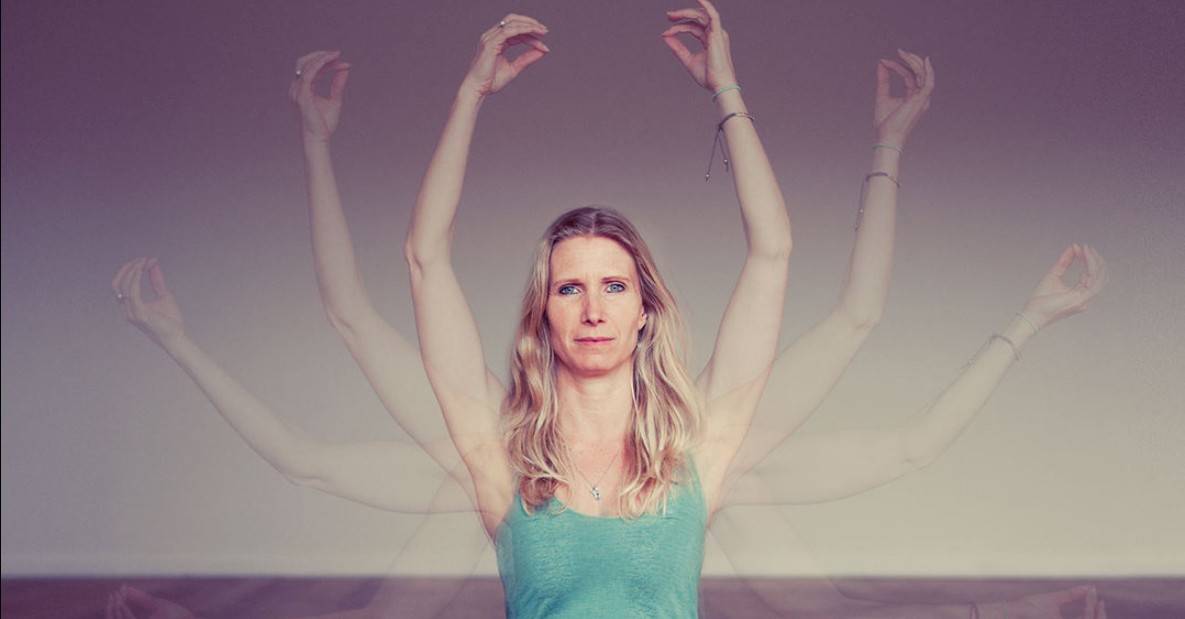There are a few different ways in which to interpret this sutra, and as we’ll learn – there’s a definite reason this Niyama is the very last. Translator of the Sutras, Swami Satchidananda even says that if you’re able to master this Niyama, there is no need to practice any of the others….
The term ‘Isvara Pranidhana’ is made up of two words; Isvara, which translates as ‘Supreme Being’, ‘God’, ‘Brahman’, ‘Ultimate Reality’ or ‘True Self’ and Pranidhana, which means ‘fixing’. In most translations of this Niyama, we’re advised to ‘surrender’ to this Supreme Being or higher self, which in essence means cultivating a deep and trusting relationship with the universe, and making each action an offering to something bigger than us.
‘God’ is a very tricky word to work with; there are a lot of people who find even discussing the concept of a God (or as in the Hindu tradition – many Gods!) uncomfortable. Yoga in no way forces the idea of God or religion upon anyone, but as you might have noticed by listening to the things your yoga teacher may say; there is an underlying idea that something bigger, more profound and pure exists other than ourselves….
This something else doesn’t need to be the figurative bearded man who sits in the sky whom we may associate with ‘God’. Swami Satchidananda’s translation of the Yoga Sutras mentions the practice of Isvara Pranidhana a lot; likely because many of the oldest traditional yoga systems based their practice upon devotion and rituals which honoured nature, the universe, or ‘god’.
In particular, Satchidananda makes a point of stating that ‘Isvara Pranidhana’ means offering our actions up to ‘the divine’ and humanity; because as we’ve all heard many times before – we are in fact all one. In the Upanishads, the word Isvara means ‘a state of collective consciousness’, which tells us – in this sense – that there isn’t a Godlike figure we are supposed to worship or devote our actions to at all, rather ‘God’ represents this collective consciousness, and therefore represents all of us too.
Applying the practice of Isvara Pranidhana to life
There are two ways of looking at this sutra when taken into daily life; it’s often described as the ‘easiest’ path to peace and realisation, requiring no effort or pain on our part – we simply let go, devote everything to a higher power and completely devote our actions to whatever we consider that higher power to be….
But could this actually be the hardest path to follow? We are so inclined to control our every action and its outcome, and ‘letting go’ isn’t always easy. If you’re the sort of person who needs that sense of ‘control’ in life, and is in constant battle with the ‘monkey mind’, (which I’m guessing is a lot of us) then Ishvara Pranidhana is probably the most difficult of the Yamas and Niyamas to follow. As we’ve mentioned, it’s not a God sitting up on a pedestal we’re surrendering to; it’s Ultimate Reality, and reality can be pretty scary sometimes….
Isvara Pranidhana in your asana practice
At first glance, the word ‘surrender’ may come across as weak, and something we shouldn’t be working towards in our asana practice – isn’t all this practice on the mat supposed to make us strong and flexible?
Surrendering in asana practice is in no way weak at all, it is in fact perhaps the strongest thing we can do. To surrender is not to ‘give up’ at all, and we can look at the aspect of surrendering in two different ways in our asana practice:
Knowing when we need to rest shows a huge amount of understanding of ourselves, respect for our bodies, and allows our practice to support us for a lifetime.
Surrender and rest
It’s the end of a long day, and you’ve made your way to your favourite Vinyasa Flow class, when you know deep down that your body could have really benefitted from a restorative session (familiar to anyone?). Halfway through class, you notice your body really needs to rest, but there’s a little voice in the mind that says ‘keep going, don’t be weak’. This is where the practice of Ahimsa and Satya also applies…. If we continue to push past our edge – instead of leaning into it – our yoga practice is no longer serving our bodies, and isn’t sustainable. Knowing when we need to rest shows a huge amount of understanding of ourselves, respect for our bodies, and allows our practice to support us for a lifetime.
Surrender to the posture
Sometimes asana practice is about finding comfort within discomfort, leaning into our boundaries and learning ways in which to deal with difficult situations. Yes, yoga makes us feel good; it heals us when we’re hurt, and it helps us find light when all we see is dark, but it also shows us what we’re made of when things get tough.
Approaching a difficult arm balance or even holding Warrior 2 for 10 or more breaths can be demanding – but it’s when we surrender to the discomfort, the strength and the power of the posture that we really feel and experience ourselves growing and transforming in that very moment. Staying in a posture for another few breaths and surrendering to how it feels right now shows us just how strong we can be in that very moment, and how even when the mind says we can’t, the body shows us we can.
The idea of ‘surrendering’ can also be applied to the intention we set at the beginning of practice; Isvara Pranidhana can be thought of as ‘offering up the results of one’s actions to the divine’, or perhaps to humanity. In this way, our asana practice becomes less about what it can do for us, but how we can help ourselves stay healthy enough to help the world around us.
Isvara Pranidhana in your work and ‘dharma’ or ‘life duty’
Surrendering our ego and our selfish desires is very closely linked to the concept of ‘letting go of the fruits of our actions’ and ‘non-attachment’, which is a focal point of the Bhagavad Gita.
If we’ve put a lot of effort into something which is important to us, we often worry about what might happen as a result; “Will they like me?”, “What if I’m not good enough?”, “Will this be successful?”…. All this worrying about things we have no control over is a main cause of our ‘dukkha’ or ‘suffering’, which means we’re never fully engaged in the action we’re doing because our minds are already thinking about what might happen after…. The practice of surrendering here requires us to acknowledge that we can do our very best in each situation, but we can’t really do any more than that; realising this essentially allows us to fully engage and be present in what we’re doing, bringing all our energy to that moment and experiencing it fully just for what it is – what happens after, happens after…. A wonderful quote by Corrie Ten Boom is a helpful daily reminder to surrender and put our energy into the present moment instead of worrying about tomorrow:
Worry does not empty tomorrow of its sorrow, it empties today of its strength – Corrie Ten Boom
Isvara Pranidhaha in your day-to-day life
In our daily life off the mat, Isvara Pranishana can be seen as less of a devotional dedication or a surrendering, and more of an ‘opening up to what is’, and instead of fighting against life’s twists and turns, remaining open to experiencing life as it unfolds.
Remaining fixed and rigid in our conditioned patterns, habits and limitations only leads to a limited life. Surrendering is hugely challenging, because it means transcending the ego, and the ego will do everything it can to hold on to some control. Without the conditioning, worries, perceptions and judgements that we falsely hold so closely to us, the ego would not exist, and therefore it tries desperately to cling on when we work on quietening it.
Surrendering to what is requires trust in our deepest Self, our intuition and the courage to express ourselves for who we are, as we are, with all of our perfect imperfections, which ultimately leads to freedom.
“And the day came when the risk to remain in a tight bud was more painful than the risk it took to blossom” – Anais Nin
The concept of Yoga Nidra and Isvara Pranidhana
In the practice of Yoga Nidra, we look to reach the Hypnagogic state – the state between waking a dreaming in which the ego-mind isn’t as in control as it might usually be. When we’re in the Hypnagogic state, we’re able to relax even more than we might do when sleeping.
This state of being is also known as ‘creative surrender’, as it is a deliberate and conscious relaxation of the mind and body. When we reach this state, we surrender and open up to reality, creating space in the mind for reality to flow through. The hypnagogic state sheds light on how our thought processes can be very different when we’re truly relaxed than when we’re in our usual mindset. It is said that the hypnagogic state is one in which there is a ‘loosening of ego boundaries’ and creative ideas are more fluid.
- Read more about our Yoga Nidra program with James Reeves and learn more about how to creatively surrender and enter a state of deep relaxation.
How to apply the practice of Isvara Pranidhana to your life
Whether it’s surrendering to a moment of difficulty or a moment of joy, surrendering the results of our actions, or simply learning to trust in the universe a little more; each time we do choose to surrender, we move closer to freedom.
Explore the Eight Limbs of Yoga in our guided online program
If you’d like to explore the Niyamas in practice, follow our program ‘The Eight Limbs of Yoga’. In this 8 week program our aim is to help you achieve a good grasp of each limb through informative talks, yoga, Pranayama and meditation. Go deeper and truly enrich your yoga practice and hopefully, your life.
Further reading on Patanjali’s Yoga Philosophy
the other four Niyamas:
- Saucha (cleanliness)
- Santosha (Contentment)
- Tapas (Discipline, austerity or ‘burning enthusiasm)
- Svadhyaya (Study of the self and of the texts)



